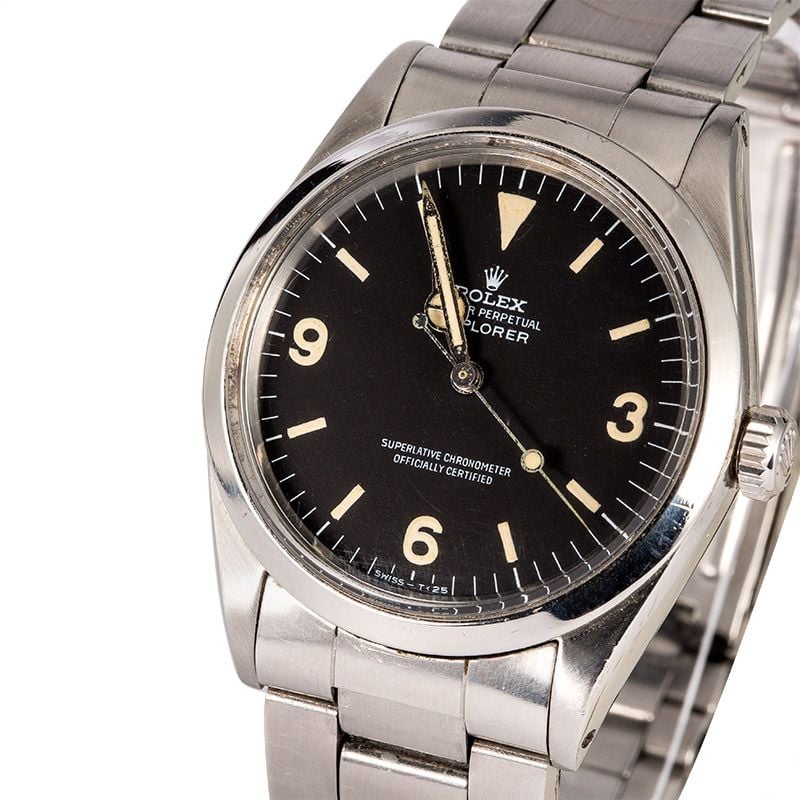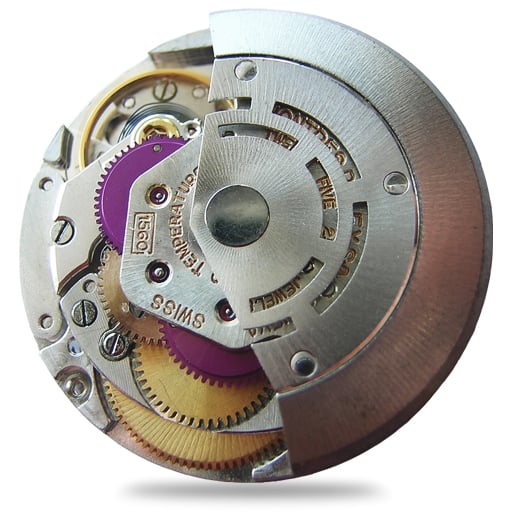Notes: The watch comes with the non-hacking movement, Calibre 1560, acrylic crystal, waterproof screw-down crown, pierced lugs.
Mechanism: The 15xx movements were in production from 1957 until 1977. In the early days of the company, Rolex sourced the intricate movements that powered their watches from the likes of Aegler, one of Switzerland’s finest watchmakers. It wasn’t until 1957 that they developed their own truly in-house movement, the 1500 series. They became a mainstay of the company, remaining in production for 20 years. Rolex proved themselves as thoroughly reliable engines inside a number of Rolex’s most iconic designs. Two of the most dependable and hardworking iterations were the Rolex 1560 and 1570. They base these movements on the same architecture as the first caliber in the series, the 1530. But where the 1530 wasn’t a chronometer grade movement, meaning it hasn’t passed the vigorous testing set down by the COSC (the Official Swiss Chronometer Testing Institute), both the 1560 and 1570 were.
The unfussiness of the original, no-date movement made it the ideal caliber to sit inside the Oyster Perpetual series. This began with the ref. 1002 released at the end of the fifties. Its modest height of 5.75mm and diameter of 28.5mm, or 12.5 lignes, allowed it to fit comfortably in the 34mm to 36mm cases of the range. Note that though this mechanism is a chronometer, it does NOT have a hacking feature.
The unfussiness of the original, no-date movement made it the ideal caliber to sit inside the Oyster Perpetual series. This began with the ref. 1002 released at the end of the fifties. Its modest height of 5.75mm and diameter of 28.5mm, or 12.5 lignes, allowed it to fit comfortably in the 34mm to 36mm cases of the range. Note that though this mechanism is a chronometer, it does NOT have a hacking feature.
Family Notes: Rolex presented the first very Explorer in 1953 to commemorate Sir Edmund Hillary and Tenzing Norgay’s pioneering climb to the 8,848-meter summit of Mount Everest, the earth’s highest mountain. Over 60 years later, the Explorer still remains a very popular choice among Rolex’s collection of sports watches.
The Explorer was based on the already existing and sturdy Bubbleback series of watches, which has been modified by Rolex for its more audacious clients. In 1952, the references 6098 and 6150 (both using the A296 movement) were in fact the first prototype watches to be used by climbers; they were watches with white dials and leaf shaped hands, which didn’t bear the name Explorer yet. In 1953, these models became the references 6298 and 6350, when they were fitted with the typical Explorer-type 3-6-9 dial and later with the Mercedes hands. Before Hillary and Norgay climbed the Everest, Rolex didn’t name their watches Explorer. Although Rolex registered the Explorer trademark on January of 1953, the Explorer gained its name after Hillary and Norgay climbed up the Everest and “Explorer” began to be added on the Ref. 6350, at the end of 1953.
The Explorer was based on the already existing and sturdy Bubbleback series of watches, which has been modified by Rolex for its more audacious clients. In 1952, the references 6098 and 6150 (both using the A296 movement) were in fact the first prototype watches to be used by climbers; they were watches with white dials and leaf shaped hands, which didn’t bear the name Explorer yet. In 1953, these models became the references 6298 and 6350, when they were fitted with the typical Explorer-type 3-6-9 dial and later with the Mercedes hands. Before Hillary and Norgay climbed the Everest, Rolex didn’t name their watches Explorer. Although Rolex registered the Explorer trademark on January of 1953, the Explorer gained its name after Hillary and Norgay climbed up the Everest and “Explorer” began to be added on the Ref. 6350, at the end of 1953.
Item created by: gdm on 2018-09-30 20:55:39
If you see errors or missing data in this entry, please feel free to log in and edit it. Anyone with a Gmail account can log in instantly.
If you see errors or missing data in this entry, please feel free to log in and edit it. Anyone with a Gmail account can log in instantly.



